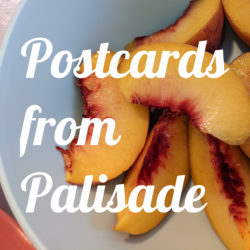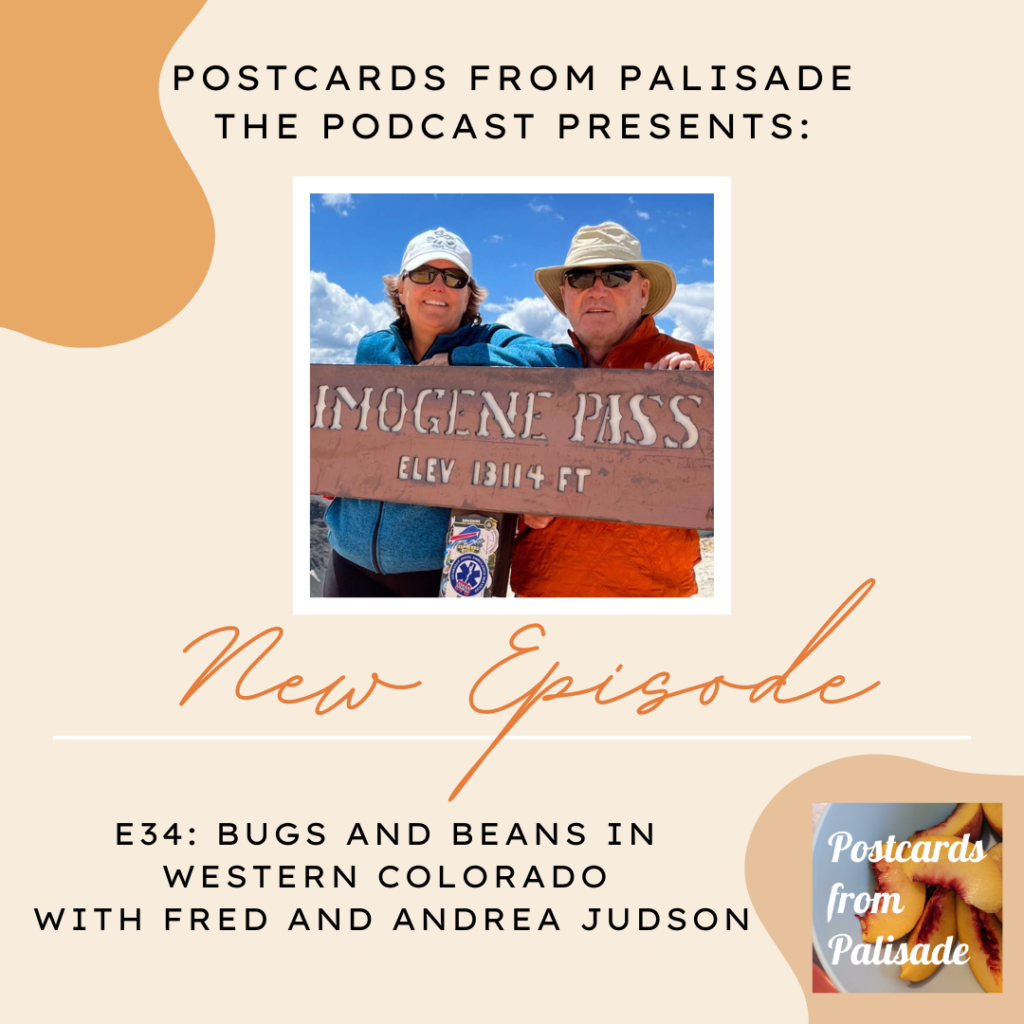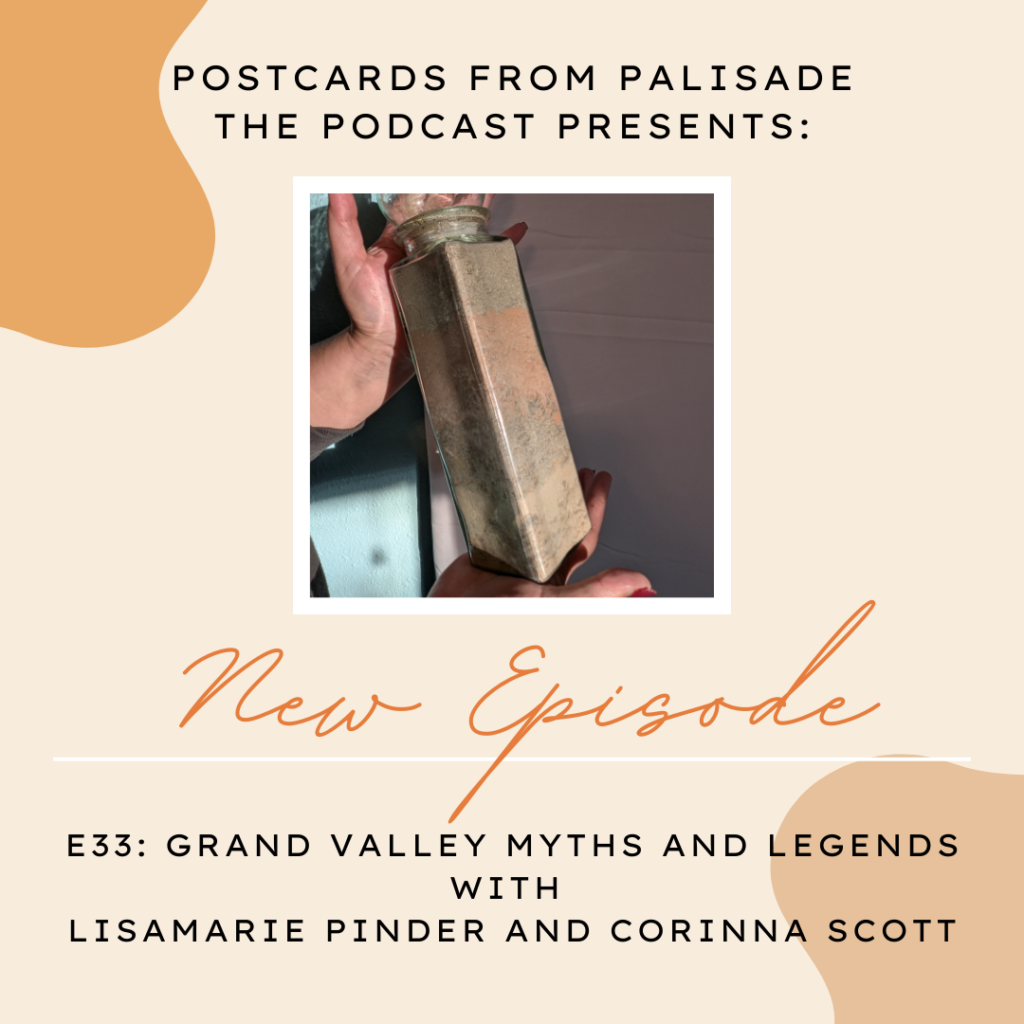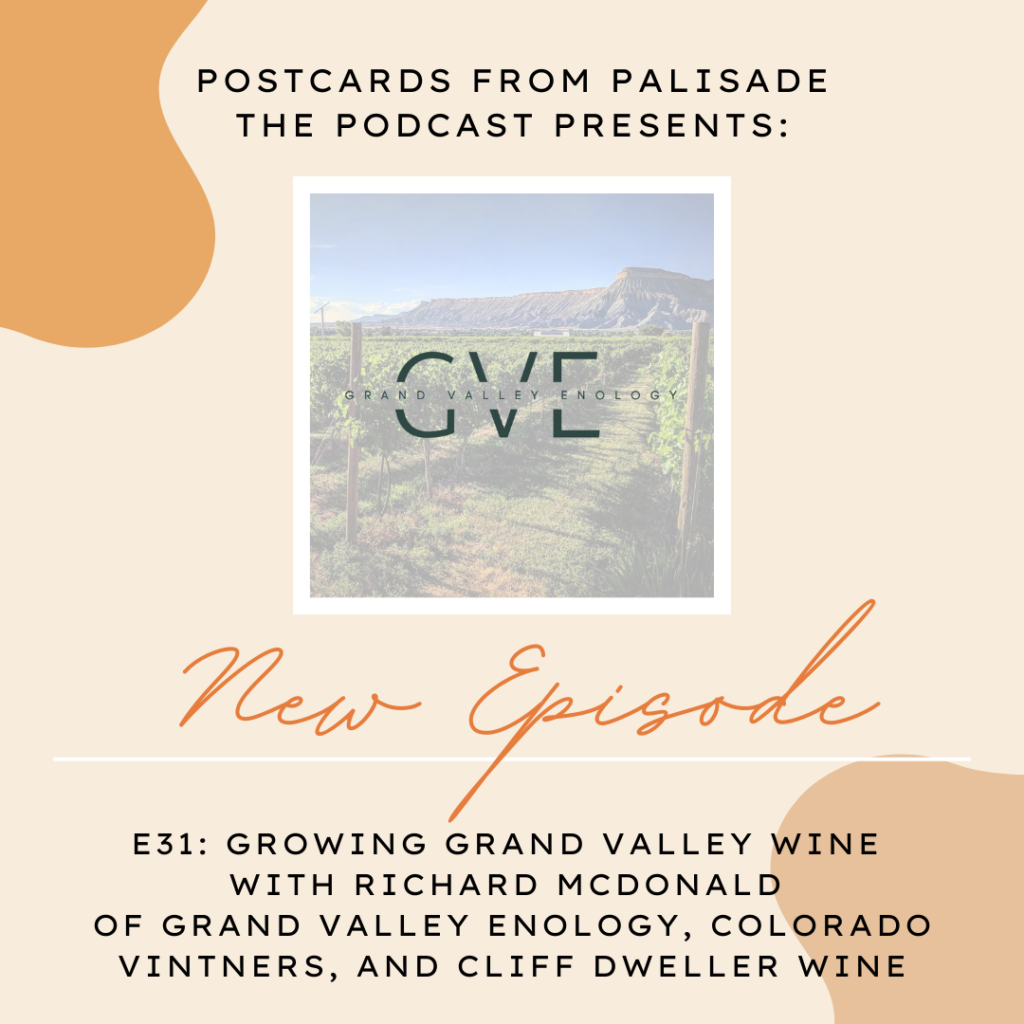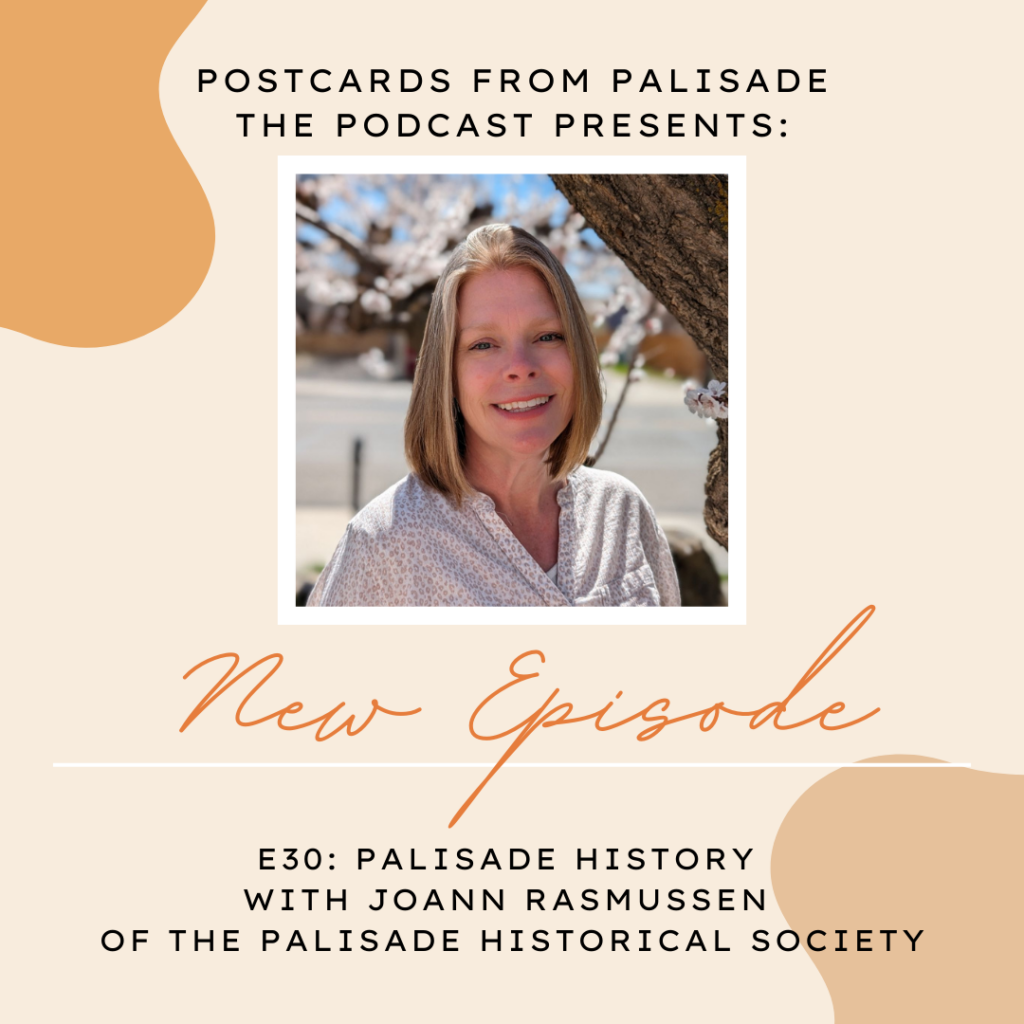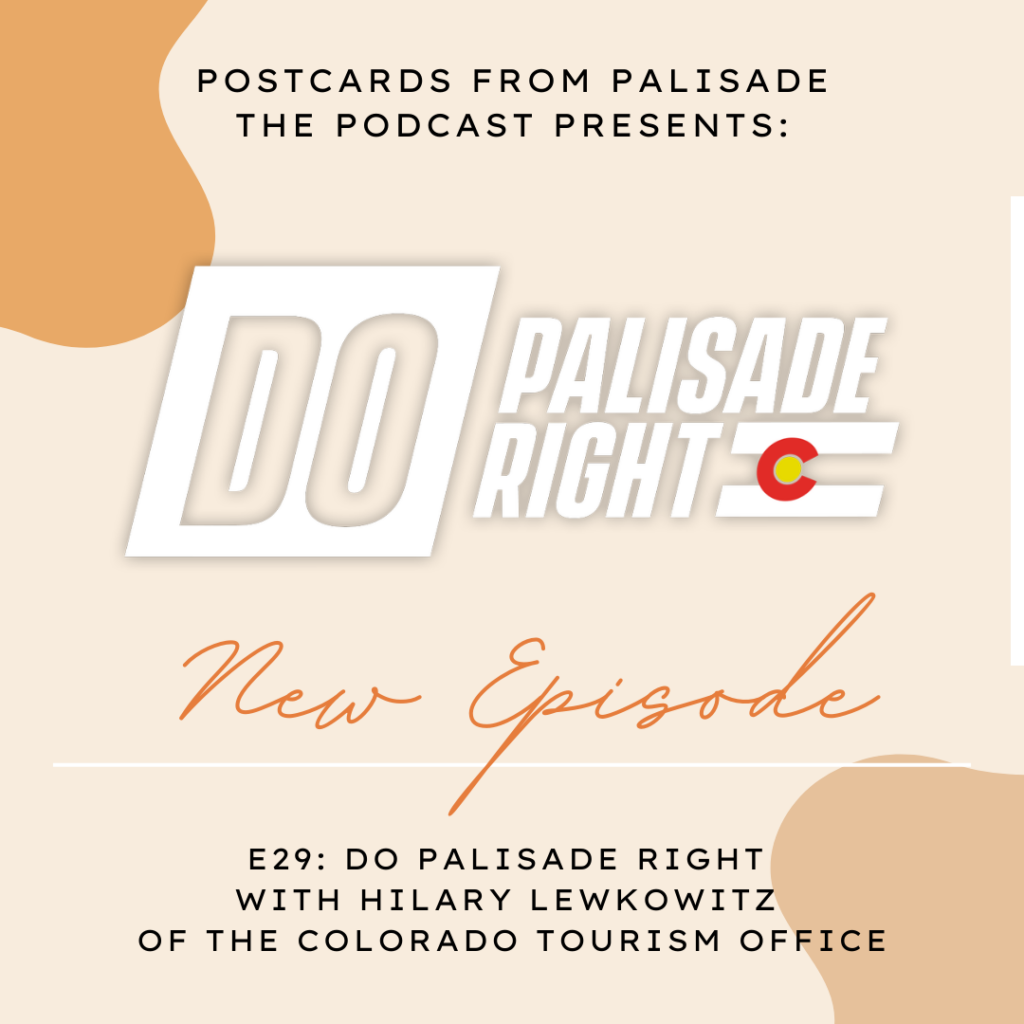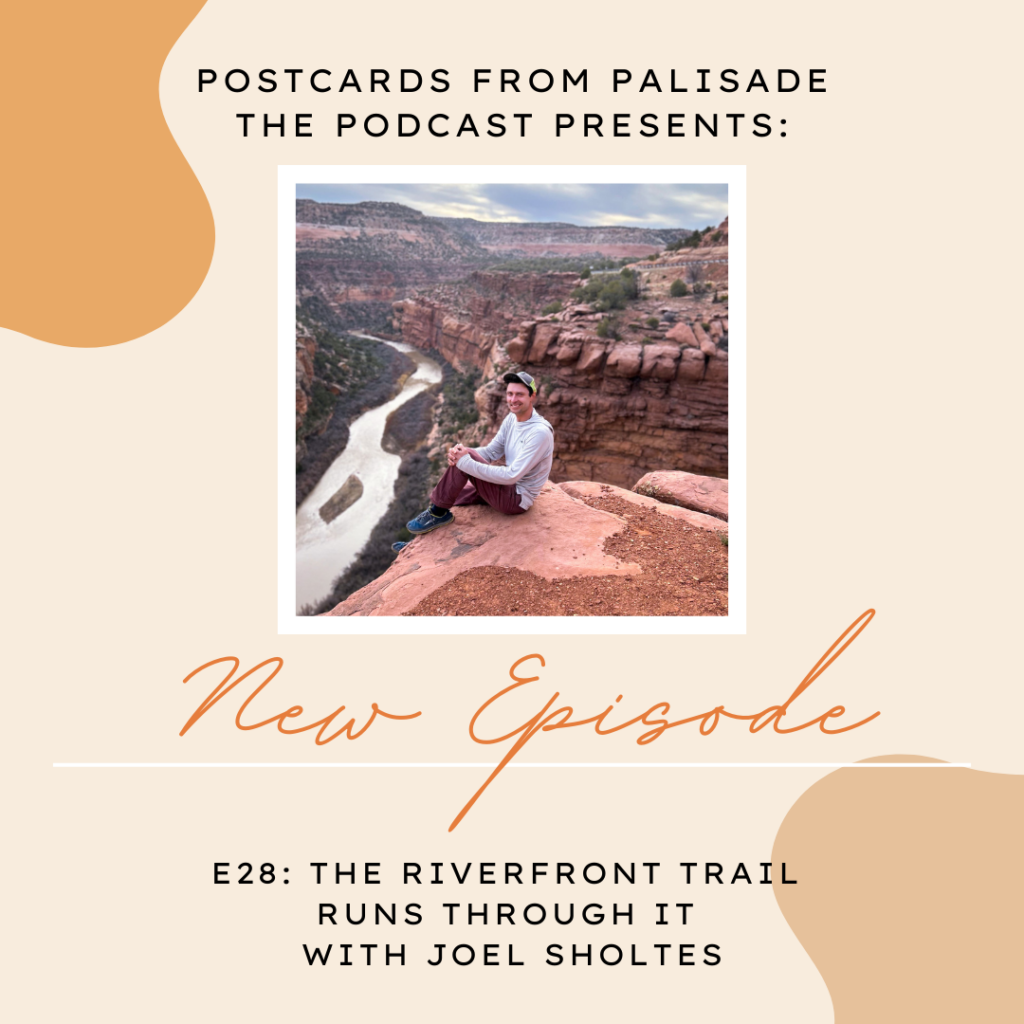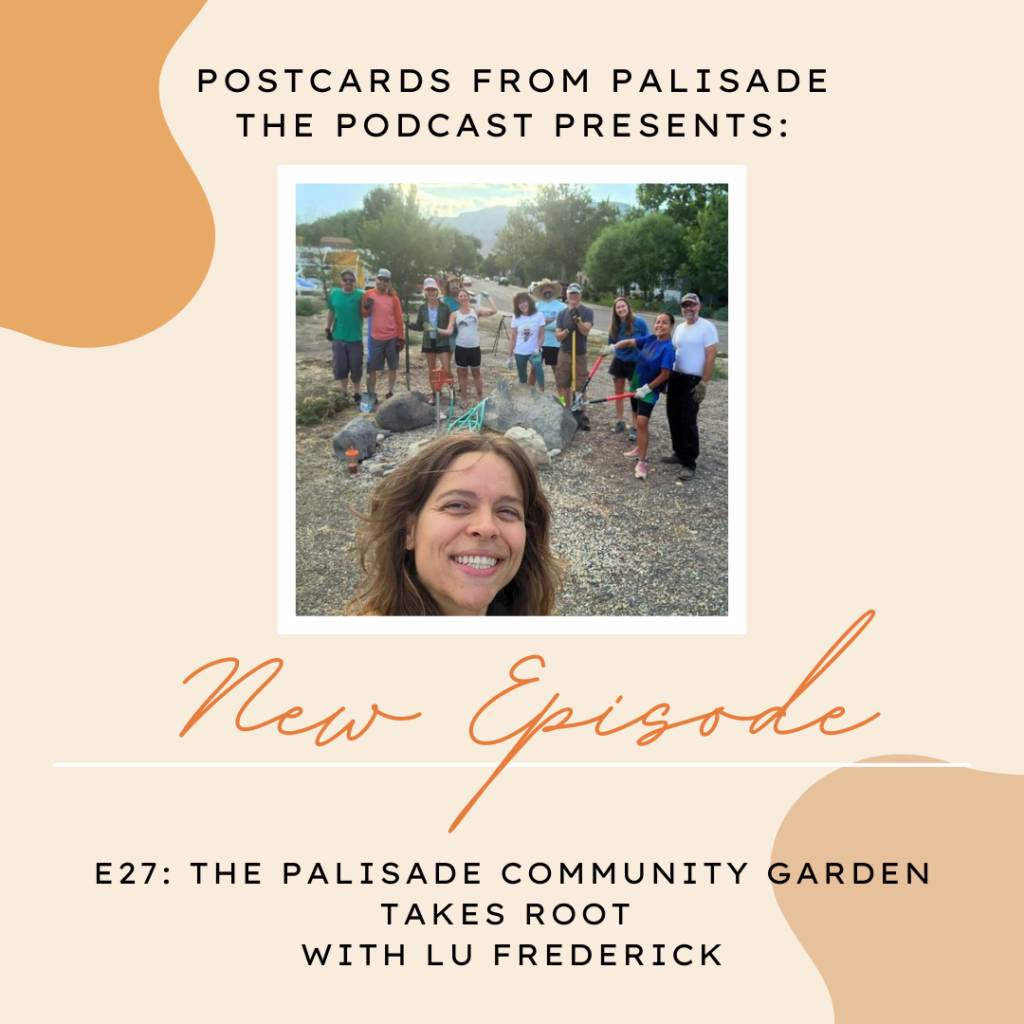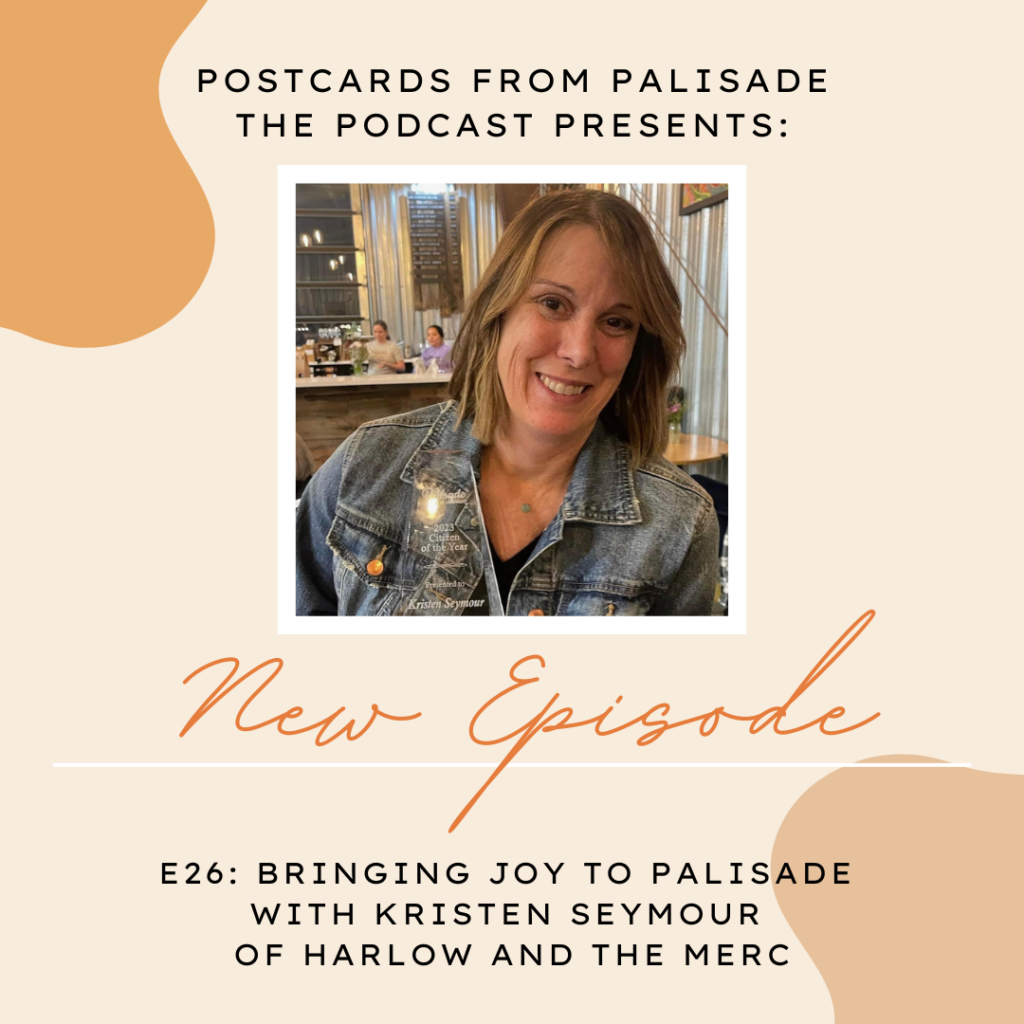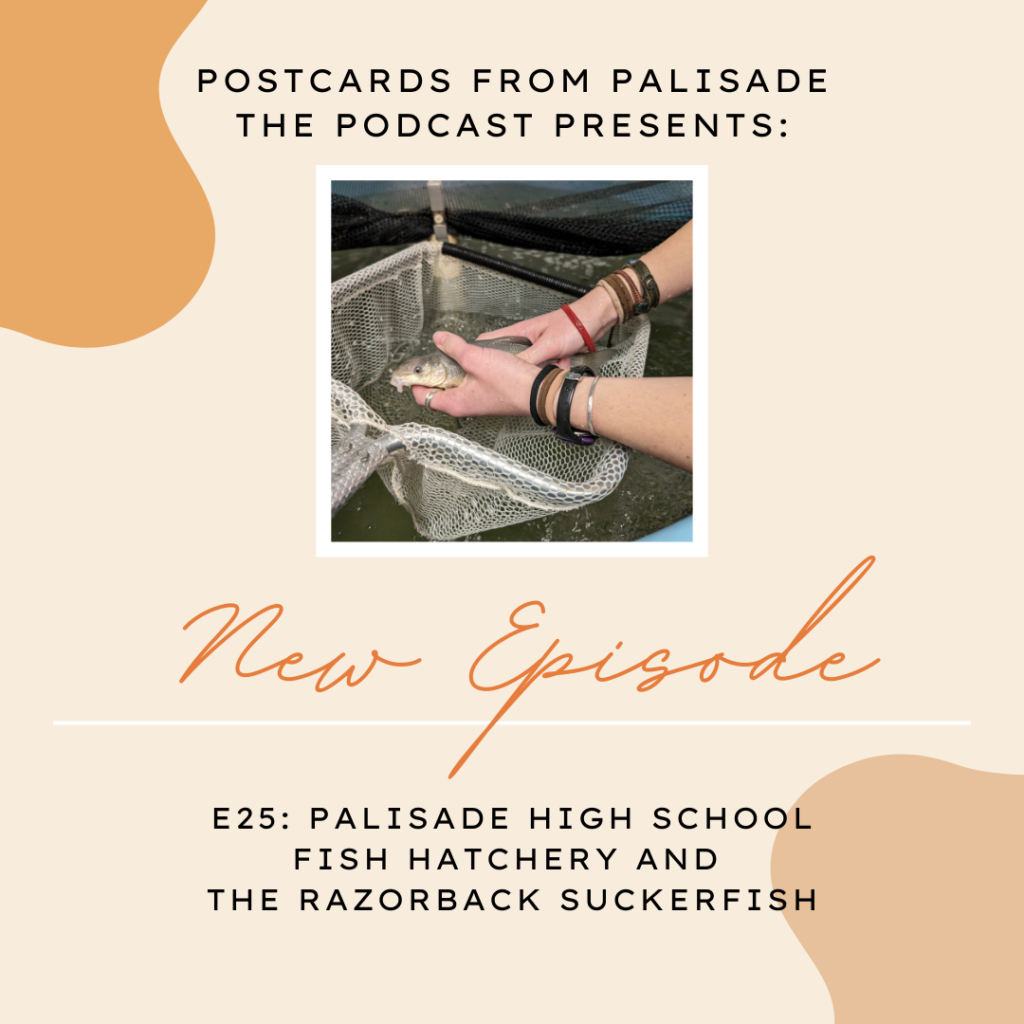Fred Judson and Andrea Judson have had very interesting careers: Andrea worked in biocontrol at the Palisade Insectary and Fred worked with disease resistant bean strains at Colorado State University’s Western Colorado Research Center at Fruita. Geek out with us about sustainable agronomy and entomology in western Colorado!
Theme Music: Riverbend by Geoff Roper
Subscribe:
Transcript:
Welcome to Postcards From Palisade, where we hear from the people who are shaping our slice of western Colorado. I’m Lisa McNamara.
Fred Judson and Andrea Judson are long-time Palisade residents whom I got to know through the Monday night community bike rides. After the ride each week, people usually hang around to chat over food and drinks, where I learned about the incredibly interesting things Andrea and Fred had done in their respective careers: Andrea worked in biocontrol at the Palisade Insectary and Fred worked with disease resistant bean strains at Colorado State University’s Western Colorado Research Center at Fruita. I knew I had to get them on a podcast episode to share the cool things they have done that have had a positive impact on the Grand Valley and beyond with a wider audience.
So come geek out with us about bugs, beans, invasive species, and more, on today’s Postcard From Palisade.
Andrea: hi, my name’s Andrea.
Fred: And my name is Fred. And, we both worked in agricultural research and applied fields in this valley for over 30 years.
Andrea: 30 plus years. So is that going to be okay if we kind of overlap in our conversation?
Lisa: Yeah.
Andrea: Okay. back when I first started, we kind of did some stuff out where he works, but then that project.
Fred: That’s how we met, actually. First time. My first week, she came out to release some Scymnus beetles.
Andrea: Scymnus and quatrodecimpumtatus. P14s.
Fred: And I got detailed to help her build an exclusion cage out in the field, which keeps other insects from getting in and it keeps the ones you release inside.
Lisa: And you said she came out. Where did she come out to? Where were you?
Fred: 19 and 10 L Road for Colorado State University’s Western Colorado Research Center at Fruita.
Lisa: Okay, and what did you do there?
Fred: I started out as the Russian wheat aphid entomologist and from there, technician for the regional Russian wheat aphid entomologists and lasted about five years in that before we fixed the problem and the money ran out. And then they offered the dry bean seed program to me if I wanted to stay here. And I did not want to go back to the Front Range at that point in time.
Lisa: Partly because you’d met Andrea?
Fred: Know, it took her 10 years to ask me out after we met. So at that point in time, she wasn’t in the picture when I moved over to run the bean program.
Lisa: Okay. Okay. So Andrea, you were. You grew up here, right?
Andrea: I grew up in Palisade. My early years were spent on the Redlands of Grand Junction. And then my father decided that he wanted to do horses and mules, so we found property out here near Palisade. And I’ve lived here since 1976, so quite a while. But yeah, I’m a native of the Grand Valley.
Lisa: like, how did you get into your career? What made you want to get into that field?
Andrea: Well, when I was. Was the summer I was 16, a, girlfriend called me and said, hey, do you need a job? And I’m like, yeah, I could use the summer job. And she goes, well, it’s at the insectary in Palisade. And so I went and talked to him and the next day I had a job. So I worked there from the age of 16 to the age of 50.
Lisa: Wow, that’s awesome.
Andrea: I worked there six years as a seasonal employee and then, 30 years as a full time employee. And I have equivalent to a biology degree, which I learned on the job. I was fortunate enough I didn’t have to go to college. for me, myself, I learned more on the job than I think I ever would have learned from a book. So I was very grateful for that job and I enjoyed it immensely.
Lisa: awesome. what was your official title?
Andrea: I was a biological pest specialist.
Lisa: what kind of projects did you work on throughout your career?
Andrea: I worked on several different projects. When I first started I worked with ladybird beetles, different ladybugs. there were three different ladybugs. Scymnus, which was a small, real small ladybug that could get in the whorls of the wheat and eat the aphids that would be down in there. The Russian wheat aphid. And I worked on the MAC program which MAC was a Macrocentrus
Fred: ancylivorus
Andrea: There you go. Fred said it. Which was a beneficial insect to help control Oriental Fruit moth which is a pest of peaches. And rearing that insect saved the growers hundreds, maybe even a few thousand dollars a year in spray costs. So and those insects, all the insects that were raised at the insectary were given back to the public for free, because the insectary is a state owned facility. So the taxpayers were paying for our jobs basically.
One of my favorite ones was working with Purple loosestrife which is a noxious weed from Europe that came over on ship ballast probably or in different seeds. And it’s very prominent on the east coast and it crowds out native grasses and cattails and clogs up the natural flow of little creeks and streams. And there was extensive studies abroad to bring in this insect called Hylobius. And it was a root boring weevil and it would lay an egg at the base of the soil and the plant and then this little weevil would bore into the roots and it took about two years for its life cycle to be completed in the roots. a professor from UC Davis in California came up with an artificial diet, to feed to these Hylobius insects and we could their life cycle instead of two years went to about two months on this artificial diet. So I had the opportunity to go to California and learn how to make this diet and release lots and lots of Hylobius, mostly in the Nucla, Naturita area but also on the east slope of Denver. There’s purple loosestrife there as well.
I worked with musk thistle, which is not a native thistle of Colorado. And we had a beneficial insect called conachus that would lay its eggs on the flowers of the musk thistle. And then those larvae would feed on the seeds, the flower seeds. So then the flower, the plant wouldn’t produce seeds. So that would cut back on the spread of the weed itself. And that was a really fun project. You got to go around with a plastic bag and bend the head of the thistles over and shake them and all these little insects would fall off into a bag and then we’d take them back to the lab.
Lisa: Oh my gosh.
Andrea: And separate all the, the trash so to speak, and collect just the insects and then have a pure insect to re-release in other areas of Colorado.
Lisa: Oh wow. Now I didn’t realize that, so I know that a lot of what you worked on, what the insectary worked on was developing beneficial insects like you say that are going to a specifically do one thing to kill a plant. and then having to go pick them up and bring them somewhere else. It’s just like even one more step. That’s so amazing.
Andrea: a lot of the insects that we released we had made insectary sites in the field. So we would go to those sites and collect from there and redistribute them. And as the insect populations grew, we had more to collect which we could re-release in other problem areas. But biological control takes a lot of patience and time. to get a good field establishment could take anywhere from 10 to 20 years. So as much as it is a benefit for us to be using that, a lot of people aren’t patient enough to get to the results. And then they end up using herbicides and pesticides to control the weed, which puts all that product in our air and potentially can be a bad, bad thing. But if you’re patient, it’s just amazing to see when it works. It’s just absolutely mind boggling that it works. But like, you know, most of our weed pests came from Europe and Asia and so that’s where the native insects came from. and then the weeds came here. There was no natural predators for them and then they just took over our native plants and weeds and other stuff.
Fred: I think now would be a good time for me to break in and talk a little bit about a misconception. You said the insectary was developing insects. They aren’t. nobody is creating new insects. What they’re doing is taking insects that exist and, and increasing their numbers and then redistributing them.
Lisa: Yep, that’s a good point. They’re not actually putting, growing a bug from.
Fred: No.
Lisa: Like you grew beans. Or like bean varietals right.
Fred: No, we’re not that.
Lisa: No, yeah, yep, good point.
Andrea: We’re just rearing them in large enough numbers that they could be released out in the field.
Lisa: Sure. Is there some though, is there some work that has to go into finding the right bug for the job?
Andrea: Well, that work goes to the USDA where they have a insectary facility in France, where those insects are brought to that facility and they go through rigorous controls to see if they’ll eat on roses, if they’re going to eat your vegetable garden, if they’re going to do other different things even before they’re brought to the United States.
Lisa: Oh, interesting.
Andrea: And then they’re brought to the United States and they go through the rigor here in the United States and Beltsville, Maryland at a USDA facility in Maryland before they’re even considered to be released in the United States. So it’s a very rigorous thing that goes through to get insects okay to come into our country.
Lisa: and that makes sense because the last thing we want to do is bring in something that’s gonna be a problem. Right. You’re trying to solve a problem, not make more problems.
Andrea: Right. There were actually two insects that we raised on purple loosestrife. And not only did we use artificial diet, but in some cases we had to grow the weed in our greenhouse. Greenhouses at the facility. And growing weeds in a greenhouse situation is very, very difficult. a potted weed just doesn’t like to be in pots. Basically. It takes a lot of, TLC to grow weeds in a controlled environment.
Lisa: that’s funny.
Andrea: So there’s a lot of strategies involved with both things. You rear the insect on weeds that you’ve cultivated in a greenhouse. those weeds aren’t necessarily as healthy as they might find out in the regular environment and where it’s located and you have to be on top of it with fertilizers. And we had weed problems in our soils that we used and we made up our own soil mix at our facility which we thought well it did help grow healthier plants, but not as healthy as that you would find out its natural setting.
Fred: They also had some insect problems in there.
Andrea: Yeah. We had aphid problems and
Fred: insectivores on their plants, the weeds they were trying to grow.
Lisa: Of course. That’s funny.
Andrea: Yeah. Our greenhouses weren’t insect-proof. They would come in the cracks and crannies of the greenhouse. But we did our best.
Lisa: Yeah. I mean you’re trying to control a lot of different things there. Why is what you did important? And again, I think it’s important, but I’m curious how you describe it.
Andrea: I think without some sort of biological control for our plant and weed pests or insect pests, we would just become overwhelmed with weed species that ah, aren’t good for anything. They’re not good for grazing, they’re not good for anything. They crowd out our native vegetation and that would just be a detriment to everyone. as slow as biological control is to get established, I would sure hate to see the program disappear because it’s so beneficial. It just cuts out huge costs to growers. farmers that have these weed problems, they don’t know how to get rid of it. Here we might have a solution for you. and they’re excited about it too. They want to, you know, see that, that what they’re doing is a safe control, that it’s not going to hurt their livestock or their kids running through the field or even just the average, person.
Fred: A successful biocontrol program reduces the amount of pesticides that are used. And everybody knows that’s a good thing.
Lisa: Yep. Yeah. I need something in my yard. Biological control of weeds. I have every weed there is.
Andrea: Well there is a control for bindweed.
Lisa: Oh yeah, I have some of that.
Andrea: You can get bindweed mites from the insectary.
Lisa: Can just a regular person go get something from the insectary?
Andrea: Yes.
Lisa: No way.
Andrea: It’s open to the public. You know, there’s there’s a limited supply. You usually get put on a list. And each season as those weeds and insects are at their highest level of production, we have staff and summer employees that will go out and collect those. And we try to fulfill each request that is received.
Lisa: that’s so cool.
Andrea: But sometimes there’s so many requests that we don’t get to everybody every year. But yeah, they’re. There are insects over there that you can actually get for your garden.
Fred: And we can show you how to collect them on your own, too.
Lisa: Yeah?
Andrea: because they are established very well in certain places. But I think the most beneficial insect that is reared at the insectary is the MAC wasp for Oriental fruit moth that the insectary started in 1945 here in Palisade. And they specifically only reared that specific insect. And to lose that culture, with the insect or to have the budget cut so it’s not feasible to rear that insect. I think that would be a huge detriment to this area. Our area here in Palisade is unique in itself and me personally, I’d like to keep it agriculture. And if that means to help out the grower or the farmer, then I’m all for that.
Lisa: So you were talking about this a little bit before, but is there, is it being that the insectary state funded. Is it something where you’re always worried about losing funding?
Andrea: Well, it was in the 80s and early 90s and part of the early 2000s. But we have our supervisor in Denver fights hard. I mean he’s the one that has to come up with a budget for everything. So he works hard, working with the legislators and saying no, this is a very important part of the Department of Agriculture and we need X amount of monies to keep it going.
Fred: we do have some budget shortfalls coming up for the state. So yeah, it’s a worry. It’s always a worry.
Lisa: Yeah, it’s hugely important for this area.
Andrea: It’s a shame that there’s not more public knowledge or that the public doesn’t have the knowledge that these things exist. it’s such a small part of the budget for the Department of Agriculture that it’s easily overlooked. Say, well, this is so much small, this is a smaller piece of the pie. We can get rid of it. But it’s such a, helpful thing for the Department of Agriculture to have that facility here in Palisade. And it’s been fought to be kept here in Palisade. there was talk many times about moving it to Denver. and our local fruit growers got together with legislators and said, no, we need it here. This saves us so much money. It’s such a, it’s a unique specialized program that it would be just a shame to see it go away.
Lisa: Yeah.
Fred: And another thing that’s interesting to point out is once you have biological control established, it’s essentially free because it regenerates itself. And it’s also affordable, it’s very cheap.
Andrea: It’s cyclic as well. as the insects eat out their food, the population of the insects will go down as the weed problems go down and then the weed problem comes back up and so will the insects. So, you know, it’s. Unless there’s some extreme thing that kills off the insects, it’ll always be out there.
Lisa: That’s cool. That is definitely one of those things that I think people don’t realize it’s happening and you don’t really miss or understand the impact of until if it’s taken away. Until it’s gone. Is there anything that you were working on that it just didn’t work out?
Andrea: Well, they all kind of work out. They may not work out like you want it to work out. even with the artificial diet, you had to be very, very careful of using clean sterile equipment to mix up that diet. Because if you get mold or mildew in those little cups that those larvae are feeding on, there’s a dead bug. and the greenhouse situation was very difficult. It was very difficult. We used to rear a little parasitic wasp for alfalfa weevil and our alfalfa in the greenhouse was constantly covered with aphids. It was constantly covered with aphids. And you know, we do everything we could to knock the aphid situation down.
Lisa: it’s ironic!
Andrea: That was my most, I think that was my most problematic was the greenhouse situation. Although I loved working in the greenhouse, that was my favorite place to be. But, yeah, was, it was a challenge. It was more like a game for me. I’m gonna beat this thing. I’m gonna make it work. I’m gonna make it work. And I tried a lot of different things to make it work and sometimes it didn’t. And sometimes it didn’t. But, yeah, as an overall 30 year career I was very blessed to have that job. And yeah, I would push biological control to anybody and everybody. If you don’t, if you didn’t know there’s an insectary in Palisade, there is. And I think anybody that hears this should look up Palisade insectary in Palisade Colorado and give them a call for a tour. go for a tour. You’ll learn some stuff. You’ll come away there with some knowledge that you didn’t know it was out there. And I think you would respect what they do there a little bit more.
Lisa: Yeah, absolutely. What’s your least favorite weed or insect? What do you see that just makes you feel angry.
Andrea: We did work with leafy spurge, which is a noxious weed and it’s toxic to cattle. It’s not a fun weed to work with because it’s kind of like a poinsettia. It has a lactic acid that comes out. It’s real sticky and gooey. But there was an insect that we tried. It was called a Hyles, a hyles moth. It was kind of like a horn worm. Looked like a tomato worm with a little horn and had different colors on it. And I could deal with the larvae when they were little, but when they got as big as my thumb, I just, or my finger, I just couldn’t deal with those. I had to have someone else come and deal with that stage of the insect. But that’s the one I least liked working with.
Lisa: Just gross.
Andrea: Just. Yeah, just grossed me out.
Lisa: That’s fair, that’s fair.
Andrea: I think just on the college level, I know that in a lot of universities, agricultural universities, entomology isn’t a. Isn’t a thing they teach. I couldn’t certainly do what I did without the people I worked with that had a background in entomology or pest management or pathogens and weeds and stuff. we’ve got to keep things like that going. As soon as that disappears, that knowledge disappears. I mean, you lose. You lose a lot of knowledge when somebody retires from their job that they’ve worked there for many years. and it can’t be helped, but, it certainly, can be improved on if those educational classes are still available.
Lisa: Right. You need someone there to pick up the baton. Like, we can’t watch a YouTube about weed management or, you know, increasing bean yield. It’s like you can watch a YouTube to do a lot of things, but that’s not going to solve everything in the future.
Fred: Well, I think an important thing that’s happening in the United States, certainly on the university level and then research level is there aren’t very many young Americans who are getting into that field. And we were filling those positions with people that we’re training, that come from other countries. And that’s not a bad thing. But I really wish that more young Americans would become interested in and involved in all facets of agriculture. And I’d also like to tell an old entomology joke while I’m here.
Lisa: OK
Fred: when you ask somebody who’s going to college if they know what an entomologist is, a lot of them will reply that, yeah, it works with insects or bugs or something like that. And I say, no, it’s a biologist with a biology job. Because if you have a degree in entomology, you’re going to be able to get a job. And that’s not necessarily true if you go into forestry or some of the other biological fields, if you get an entomology degree, you’re guaranteed you’re going to be able to go get a good job.
Lisa: because it applies to so many different fields or?
Fred: Yeah. Well, you can’t have food without, you know, insect control of some kind, whether its biological or using, you know, some of the integrated pest management techniques that we use now. And you know, you need people who understand how to do that and are developing new techniques for managing insect pests as well as just the ecological, side of entomology too. And that’s probably even more underfunded than the agricultural side is. you know, we all know that we have problems with pollinators and the declining numbers and species of insects that we have worldwide is becoming a huge problem. Habitat loss and pesticide use has really decimated the numbers and types of insects that we have. you people all know about the non native European honeybee, which wasn’t in North America up until the 1700s, but we have lots and lots of other pollinators, bees and wasps and accidental pollinators like miller moths and.
Andrea: ants even.
Fred: Yeah, anything that essentially touches a plant can pollinate it.
Andrea: Birds.
Fred: Birds, there’s some mammals. There was a recent study released that show that wolves in, the Middle east are actually pollinating a rare type of plant because they like to rub their muzzles on it. And when they’re doing that, they’re picking up pollen. When they do it again, they’re transferring that pollen to another plant. So, yeah, the entomology world is big and boy, there’s some pretty serious issues that are happening in the world right now with entomology and, you know, lack of insects, insects that are dying out on us.
Andrea: Yeah. Would be great if, people weren’t so insectphobic. Insects are cool. The majority of them will not hurt you.
Lisa: Right. That’s a tough thing to kind of stay positive in the face of that thought. it’s just awesome that you both really worked towards trying to solve that big problem. And I don’t think it gets a lot of attention either. It’s like another one of those things that you don’t notice until it’s not there anymore.
Andrea: Well, the Insectary, like I said, has been here since 1945. The population of Grand Junction, maybe 5% knows that. That’s horrible. We need more public education people that go out there and promote not just with our legislators, but to the general public. And there are, you know, that does happen to a certain degree with the staff at the Insectary. But I think that, I mean that could be somebody’s full time job over there. There’s not the funding for that type of person. So again,
Fred: if the general public knew about all the good work that’s being done over there, they would knock down the doors of any legislature who tried to cut the funding out from under him. So a little more visibility would be great. We need to get the word out that this is here in Palisade and it’s doing really, really good, important work and it needs to continue.
Lisa: How much of your time do you spend, like, talking about bugs?
Andrea: A lot. I mean, we travel. We travel the world, and, we can’t get away from our jobs. We’re retired. But it’s just like, you know, you go someplace new and you see a weed or something, and it’s like, oh, my God, look, they have that here. I wonder if they’re doing anything about that. And a good example for me was we traveled to New Zealand, and lo and behold, we go in this botanical garden in Christchurch, and they’re propagating purple loosestrife.
Lisa: Oh wow.
Andrea: And I was just like, oh, my God, they’re growing it here. And I
Fred: intentionally.
Andrea: Intentionally, yeah. And I found the curator, and they said that was no problem.
Lisa: Really?
Andrea: I’m like, you got to be kidding. It is a huge problem. And later that day, we took a little paddle boat down the Avon river, which, went right by the backside of the botanical gardens, and there was loosestrife growing in that waterway, and it went clear to the ocean.
Lisa: No way. Wow. That’s
Andrea: Yeah.
Lisa: That must have made you see red.
Fred: We often will be driving somewhere, and we’re like, oh, my God. Dalmatian toadflax. And then we’ll stop and pull it all up.
Andrea: Yeah, if it’s a small patch we’ll pull it. Even, a lot of people think that, butter and eggs, it’s called. It looks like a snapdragon. It’s yellow.
Lisa: Oh, yeah. Yellow with the orange center.
Andrea: Yeah. And it’s called
Fred: yellow toadflax.
Andrea: Yellow toadflax or butter and eggs is the more common name for it.
Lisa: That’s bad? I didn’t know that was bad.
Andrea: yeah, it crowds out native vegetation.
Fred: This valley has a huge problem with Russian knapweed. It’s getting a lot worse. People don’t recognize it. And I can see from your face that you don’t.
Lisa: Yeah. What does it look like?
Fred: well like woody form with a very deep perennial taproot. Purple flowers that people think are pretty. And it grows in monocultures. It actually performs chemical warfare on its neighbors, which is called allelopathy, where the roots exude a chemical which prevents other seeds from germinating and other plants from encroaching on it. So it produces these dense monocultures.
Andrea: I worked on that towards the end of my career and that’s. That was a. Not a fun one to work with.
Lisa: Yeah, I don’t think I have any of that in my yard. So I have that going for me.
Fred: Typically you won’t find it in a yard but roadsides railroad right of ways. There never used to be any between Palisade and Clifton on Highway 6, and now there’s some pretty big patches of it. Next year they’re going to be bigger.
Andrea: Because nobody knows what it is. Which you would think that CDOT should have a noxious weed person in their office or several.
Lisa: Right.
Fred: Well, they used to, but budget cuts, they take people like that out of the equation fairly quickly. Well, I haven’t seen the numbers recently, but somewhere around 90% of all of our pesticide use in the United States is used against invasive species that don’t belong here.
Andrea: Whether that’s plant or insect.
Fred: Yeah, plants and insects.
Lisa: That’s amazing.
Fred: If we’d had a better quarantine system, we’d be far better off right now.
Lisa: What was your official title?
Fred: I was technically a research associate. And I went through 1, 2, and 3 as I, progressed up the ladder.
Lisa: what would you call yourself if you were introducing yourself to somebody at a party?
Fred: I would say I was a bean geek. basically, you know, running the bean seed program. We worked with the breeding program and the seeds came to me and I increased those seeds in the field until we had enough to go to trials with them. So, no, I was an agronomist essentially. You know, started out in entomology and then moved over into a specialized field of agronomy, plant breeding, if you will.
Andrea: Which is odd because I worked with insects and Fred was an entomologist and didn’t work with insects.
Lisa: Yeah. That’s interesting. So you both are entomologists at heart, but maybe not even at heart. You now you’re a bean geek at heart.
Fred: Yeah.
Lisa: I think a lot of people who aren’t from Colorado or haven’t been here are surprised that peaches and grapes and things grow here in western Colorado. I don’t know if anybody ever thinks about beans. So why are beans important here for this area?
Fred: Well. I think the single most important thing is that dry beans, pinto beans, a few black beans, yellow beans, that we’re growing here now, they’re all very susceptible to bacterial and fungal diseases. And the factors that increase the problems with those are humidity. And we have very low humidity here. So Mesa County, Delta county and Montrose county are the only three counties that can reliably certify disease free seed. If you start with disease free seed and you plant the seed in an area that has disease problems like eastern Colorado, then you’re going to get probably an additional 30 days of growing season before those diseases manifest themselves in the plants. And this is our earlier genetics, later genetics, we had bred a lot of disease resistance into these plants so that we weren’t, we didn’t really need fungicides as much. But you could delay it essentially by 30 days, the onset of having disease issues by starting with disease-free seed. And that’s why the seed program was here in western Colorado.
Lisa: are beans actually grown commercially around here?
Fred: it used to be a much bigger crop, particularly in Delta and Montrose counties. The price received for producing edible beans is very low compared to some other crops. And it’s seen more as a rotational crop so that you can break disease and insect cycles by rotating in. It’s not really a moneymaker. the guys who are making a little bit more money are the guys that are producing seed. But we’re competing with areas like a small area in Wyoming and Idaho. the state of Idaho is huge in seed production, disease-free seed production, and we haven’t been competing well with them. Part of it’s a scale of economy thing. We’re just too small.
Lisa: is the program still going on today?
Fred: It is sort of going on. When I retired, the bean breeder in Fort Collins who ran the dry bean seed breeding program, he also retired and CSU decided since it’s really a minor crop that they wouldn’t replace him. And also, you know, initially in bean breeding it was all done by USDA and universities. And in the last 20 years private industry has gotten more involved in it and perhaps that’s where plant breeding belongs, is in private industry. I mean we built a lot of really good things in the government sector that helped it along. But there are, mostly private breeders going on, private breeding companies going on right now carrying on the lines of dry bean seed.
Lisa: Andrea, we started to talk about earlier was the funding. So who funds it, who thinks. Who spends the money on it? Right.
Fred: The dry bean seed program was self-funded because we, the breeding program made the crosses and then sent the seed to me. Those seeds were increased in the field so that we had a large enough volume of seed that it could actually be sent out across the United States for head to head trials with other varieties so that we would get information. Obviously the most important one is yield. I mean you have to yield enough to be able to sell it and make some money at it. But also we needed disease resistance and plant architecture that’s upright and makes it easier to harvest and things like that.
Lisa: It must take a really long time because every year you’ve got to, you’re limited to like natural growing conditions. So every year you have a new crop.
Fred: We are. And you know, initially, When I started 35 years ago, it would take about 10 years to bring a cross into a publicly released variety. you start in the greenhouse, you make a cross and you get 26 seeds or 30, a very small number of seeds. And then those seeds would come to the field. In my case, it would come to western Colorado. And I would plant them as individual plant rows and keep track of them as they grow. Because a new cross is still segregating. It’s essentially a hybrid and it’s going to take in case of beans about four years for the outcrossing to disappear. But you have to recognize when those plants are segregating and then keep them separate so that the seed is pure seed.
Lisa: So you have to be very patient.
Fred: And we also, in the early days we didn’t have, the ability to see, essentially to look at the DNA of a plant. But in later years that ability was much greater. So you could actually see what the genomes are in the plant and breed accordingly for that. And also later in our career we had established ourselves in the United States as one of the premier programs. So we were selling our seed and making a little more money and we could afford winter nurseries then because you only get one generation a year in the Northern hemisphere. So initially we sent seeds to Brazil, but it came back full of diseases
Lisa: Counterproductive!
Fred: and that set us back farther than it advanced us. And about the last eight years of my career we were sending seed to the North Island. Excuse me, the north end of the south island of New Zealand where they had very similar growing conditions. And we found a guy who was really good at seed production who could do it for us. So we would get two generations. So that cut essentially 10 years into five so that we could increase the amount of seed that we had available.
Lisa: why is what you did important? I think it’s important, but like why would you say it’s important.
Fred: when people started trying to improve and that’s what we do with crop seeds when we breed them. We’re trying to improve things. primarily yield, disease resistance, seed quality, things like that. We did it because we were getting really low yields. In the 40s and 50s the yield per acre of dry beans was around 600 pounds per acre. Even in the 70s and 80s we were only up to 1,100 to 1,200 pounds per acre. And through selective breeding where we bred for yield, we bred for disease resistance and plant architecture, the plant shape that made the plant able to yield more, we increased those yields from initially 500 to 600 pounds in the 50s and 60s, all the way up to 4,000 pounds in the modern era. And I think it’s also important to say that the breeding techniques being used are pollen transfers. They’re the old fashioned. You cross plant A with plant B and you hope to get a good result. There are no GMO dry beans in the United States.
Lisa: That’s an important point.
Fred: The only one that I’m aware of was a plant that was bred in Brazil and they actually asked permission to use some MA Colorado State University’s genetics for this cross to defeat a virus problem that they have in the southern hemisphere. So the reason we’re doing it is number one, a farmer has to make a profit. it’s a business just like any other business. If they can’t make a profit,
they can’t stay in business. So in order to do that you need to have a plant that you know, has high yield and lower inputs. In this case fungicides, primarily disease resistance that we bred into the root system and to the leaves, typically in somewhere eastern Colorado, western Nebraska, where they have higher humidity, they would have to make two to three applications of a fungicide every year in order to get a full crop. And with that disease resistance that we and other institutions spread in, we took that down to zero in many cases. So we increase, increased the yields four fold, and we decrease the amount of inputs, especially pesticide or fungicide specifically. So I think that’s a pretty good thing.
Lisa: That’s pretty cool.
Fred: People don’t realize in the United States because we have a lot of food choices, but in third world countries, dry beans and rice are what feed the majority of people. So, not only did we benefit from it, but those other people get to use our genetics. University programs don’t really prevent other people from using the genetics like some of the private companies do. We did patent our seeds so that growers would have to pay us a very small royalty in order to use our seeds. But nothing compared to private industry.
Lisa: Interesting. Seems fair.
Fred: Well, we patented them because we had to fund our programs.
Lisa: Right.
Fred: You know, the taxpayers can’t foot the bill for everything. if you’re able to generate some income by selling the seed that you have bred and then later released to the public, then you can pay for the program.
Lisa: Yep. Makes sense. Fred, was there ever like any challenge or any project you had that you just weren’t able for some reason to solve? What made you just bang your head against the wall?
Fred: Well, dry beans are traditionally harvested by cutting the roots and piling them in a windrow and letting them dry and then combining them. And this is because the pod load is carried very low on the plant. So it’s not like a soybean plant where you can run a sickle bar or a combine head under them and pick up the whole plant. So it’s cut and then wind rowed into a, you know, like, hay. And then you come by and pick it up with the combine after that. But when it’s cut and laying in that windrow, it’s very, susceptible to wind. Can blow it away or rain can get on it and cause, you know, mildew, it discolors the seeds, all sorts of things.
And all the programs in the United States are still working, that are left, are still working to essentially breed a direct combinable dry bean. One that that carries its pod load high enough off the ground that a sickle can get under it and harvest the whole plants all at once. That will take away problems that you have with losing yield because of wind and also damage by water, thunderstorms, etc. And it’s not been real successful yet. I mean it’s a slow change. it’s very common for direct combining to occur in places like North Dakota which have more wind and rain problems than we have. And they are losing a lot of yield because they’re harvesting our old fashioned dry beans that have the pod load very close to the ground and they’re accepting a 25% loss in order to avoid having their beans blow away or get ruined by a thunderstorm. So eventually somebody’s going to get the right genetic combination, will have a very strong stem that carries the seed pods very high off the ground. It’ll happen someday. But that was one thing that we tried for a long time and just, it was frustrating.
Lisa: Yeah. That’s so interesting though. It’s like the relay race of, you did such a big piece of it and then you pass it on.
Andrea: anything that has to do with agriculture is a long, drawn out process and there’s a lot of patience and hard work that goes into that. I personally don’t grow a garden. We do grow a garden but
Fred: Fred grows a garden.
Andrea: Fred grows a garden. I would just as soon help our local growers. They work hard at it. I’ll pay them to grow my food.
Lisa: I completely agree with you by the way.
Andrea: It’s just a slow process and you just have to have patience. Patience is huge.
Lisa: Yeah, I’d rather pay the farmer to grow my food personally because I’d starve.
Fred: I spent 40 years in agriculture and I still really enjoy growing my garden, my small garden in the backyard.
Lisa: I mean the food does taste great when it comes out but.
Andrea: Fred has always wanted to plant fruit trees in our yard and I’m like no, we’re gonna support our local grower.
Fred: Agricultural research at a university level is suffering from really bad funding. And I think that’s definitely the biggest problem that we had. And we were using 40 and 50 year old equipment and we spent as much time mechanicking and fabricating equipment to keep it in the field to perform the research. And you know, the dry bean harvesting that was going on at the Western Colorado Research Center, to me it’s mind boggling that we will not fund agricultural research in the United States to the level that could really make it so much, so much more powerful. I mean we could do great things if we weren’t fighting poor equipment all the time.
Lisa: Yeah, that’s a good point. When you have to spend a lot of time repairing things. So you really had to be multifaceted there to keep things running.
Fred: Well, I came out of of college with an entomology degree and I didn’t really have very good mechanical abilities. But I learned. I became a fabricator, a welder, troubleshooter, problem solver and you know, it’s good to have that ability. But if we’d had better equipment to start with, we could have put much more effort into the actual nuts and bolts of what research is in the field.
Lisa: So looking to now or to the future, what do. It’s you probably just already answered that. But what do you think is the biggest challenge that our current kind of generation of researchers and scientists are dealing with in the Grand Valley, what do you see is being some of the big issues in the future that they’re gonna have to figure out how to handle?
Andrea: funding.
Lisa: that’s what I was like, I feel like you probably just answered that.
Fred: And also, you know, I’m going to come at it from a row crop agriculture position because that’s what I did. And that’s somewhat different than the fruit a little bit. But the two biggest problems I see are water availability in the future. I mean everybody, there’s a water shortage and everybody wants our water.
Andrea: That’s true for the fruit industry too. For anything.
Fred: Well, it is, and they’re going to either buy our water from us and it’s already happening in the back in the Grand Valley. You know, large wealthy corporations or whatever you want to call them are already buying water shares from this valley. and another problem that people probably don’t see is we have a big salinity problem. Our soils are becoming. If you irrigate soils, they will leave behind what’s in the water. We have a lot of salt in our water, it comes from the mancos shale formations in the valley. And, high saline soils will reduce our yields and they are becoming slightly more saline. So we need to work on methods that will, not only leave less, less salts in our soils, but also breed plants that are salt tolerant. And it’s not just a local Grand Valley problem. This is a worldwide problem.
Lisa: So you agree on water and funding?
Andrea: Oh yes. Most definitely.
Fred: In an area like ours, it gets 10 inches of precip a year. You’re not going to grow anything without supplemental water. And it’s got to come from somewhere. And, all those people downstream from us, they want it as badly as we do and they’re wealthier in a lot of cases. We didn’t even talk about the tamarisk.
Andrea: Yeah.
Lisa: Oh yeah.
Fred: Which has been a success story.
Andrea: Yeah, that’s a huge success story. I didn’t work on the project myself but I knew enough about the project. tamarisk was brought over from Eurasia as a like
Fred: soil stabilizer.
Andrea: soil stabilizer, wind block. and it got out of control. so there’s an insect here that we reared at the insectary. Two different species and it’s a leaf defoliator. so the larvae feed on the leaves. They get to full term as a larvae. They drop down into the ground and pupate. And then the adult emerges and the process starts over and over and cycles like that. it’s been a huge success story on the Colorado river. As you may have noticed driving from here to Fruita or even Moab. there’s been a lot of mechanical use on it in the Moab area where they go down and cut it off and then put it through a chipper whatever.
Fred: Dig up the roots.
Andrea: Dig up the roots. But the tamarisk beetle is a huge, huge.
Fred: You’ll be driving along the Colorado river and see what appears to be dead or dying brown plants. That’s from the tamarisk beetle.
Lisa: OK
Andrea: It’s not from herbicides or chemicals.
Lisa: Not from a drought or anything like that.
Andrea: Nope. Those insects, they pick out the. I don’t know how they sense which tree to go to because one tree will be covered with insects and the other trees not. Doesn’t have anything on. I don’t. There’s some sort of pheromone, natural pheromone that the tamarisk, tree puts out that attracts the insects. And but yeah, the insects will keep attacking it year after year until it finally kills it. and then if it does come back at the roots it, it will get that new growth from coming up and spreading it again. But yeah, the tamarisk is one of the biggest salt emitters in the Colorado river basin.
Lisa: Right. So, yeah. So do you see many like healthy growing tamarisk around anymore?
Fred: Oh yeah, lots.
Lisa: Yeah?
Andrea: Yeah, lots.
Fred: But not like it was.
Andrea: I mean you’ll even see it in. Well, we go to the San Rafael swell a lot to ATV and even in the canyons there, where you wouldn’t even think it would be there. There it is, you know, but it probably got spread by a bird, picked up a seed and got dropped off by an animal or a bird or something. But yeah, it’s amazing how quickly it will take over a willow, a natural willow. where willows can be just as thick and dense to get through as a tamarisk culture. But the willow is native and that was one one problem that a lot of people were against releasing the tamarisk beetle because there was an endangered bird that nested in the tamarisk
Fred: Willow fly catcher.
Andrea: the western willow fly catcher. But what they didn’t realize is as soon as the tamarisk is gone, the willows will come back and there will still be the place for the bird to nest. well, I don’t know if I should go into that.
Fred: There is a real missing component of biological control, and it comes back to the nature abhors a vacuum, is if you bring in an insect and it wipes out whatever weed was there, you’re going to have bare ground, something is going to come back in. And if man doesn’t do it, and we aren’t currently doing that very well, it’s going to be another invasive weed. You can see it in De Beque Canyon where we had the big fire that killed all the cottonwoods and a lot of the tamarisk. We’ve got a huge Russian knapweed problem coming in there now.
Andrea: taken over by cheat grass.
Fred: If there’d been a mechanism for having people to come in and re-seed it and re-vegetate it, we would have maybe been able to prevent that from happening. It’s a missing component.
Lisa: Sure. Yeah. Because what’s gonna take over after something has been burnt especially is whatever grows the quickest and easiest.
Fred: Yeah, that’s gonna be an invasive probably.
Andrea: Invasive probably. more than likely.
Lisa: Before we end, I’m curious from each of you. What’s your favorite thing about Palisade? That’s something I like to ask people. Like what keeps you here?
Andrea: that is small. and there’s no traffic lights. And other than the big gas station out by the interstate, it’s pretty much, light pollution free.
Lisa: Yeah. Great stars.
Andrea: It was a great place to grow up. And the fruit here is very beneficial too. So.
Fred: Yeah. I love our small town culture and the people that we have in Palisade. We’ve got some really great people here.
Andrea: It’s a friendly place for the most part whereas you go into Grand Junction, people just put up their little blinders and keep on doing what they’re doing. But you know, here you can pretty much stop on the street and talk to anybody, which I like that about a small town. I wish my nieces and nephews would have grown up in a small town.
Fred: If you’re an outdoor recreation minded person, there’s so many things. It might not be right next door in Palisade, but we can go into the Utah canyon country. We can go look for petroglyphs, we can cross country ski on Grand Mesa, ski at Powderhorn, raft the river. Not very many places that have all those things right together.
Lisa: Well, thank you both so much for your time. This is really great. I really appreciate it.
LM: As I was editing this episode, I realized that Fred, Andrea, and I spent a lot of time talking about invasive species but we didn’t get into what the average person could do to stop their spread. So I reached out to them afterwards to get their thoughts. This is what Fred said:
“Regarding invasive species, it’s most important to be knowledgeable and aware. For most people this means just to be aware that invasives are a problem for any ecology […] just the idea that it’s a problem without knowing specifics is good enough.
Buy plants from a reputable local nursery; [choosing] native plants [is] a way to avoid invasives and [is] better for our environment since they are adapted to our climate, possibly drought tolerant, and may benefit other natives like native pollinators. [To paraphrase something we talked about too: don’t collect seeds you find somewhere and plant them at home because you could easily be planting an invasive species.]
If in doubt get expert advice. Colorado State University’s Tri-River Extension office in Mesa County will have the best up to date science-based information on plants and insects. Call or visit them at the county fairgrounds and they will direct you to an expert.” You can reach them at 970-244-1834 or https://tra.extension.colostate.edu/
Thanks to Fred for the great tips, and to Andrea and Fred for the hard work they continue putting into improving the valley they love.
Are you currently doing work in these or other biological fields in the Grand Valley? If so, I’d love to hear from you. I’m also still looking for more Grand Valley myths and legends – either your take on what we covered last episode or others that we didn’t get into. You can email me at lisa(at)postcardsfrompalisade.com.
The podcast’s theme music is Riverbend by Geoff Roper.
Thanks for listening. With love, from Palisade.

